101 High-Protein Foods That Go Beyond Chicken and Eggs
Protein is an essential nutrient that helps build and repair tissues, make enzymes and hormones, and support a healthy immune system.
Whether you’re an athlete, trying to lose weight, or simply looking to maintain good health, incorporating a variety of protein-rich foods into your diet is crucial.
This guide will explore 101 high-protein foods across different categories, helping you make informed choices about your nutrition.
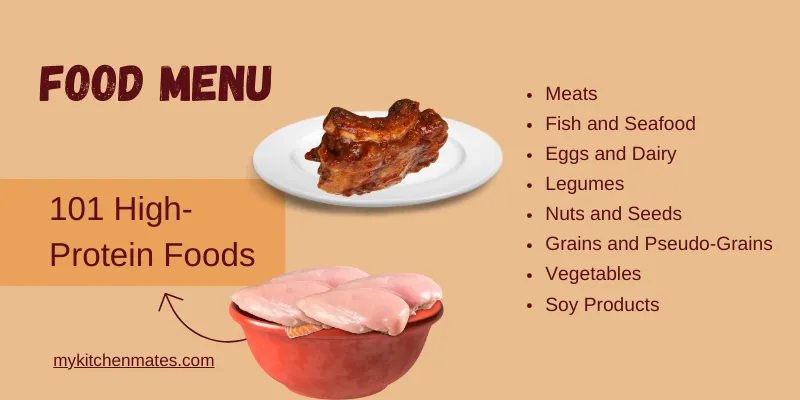

Animal-Based Proteins
Animal-based proteins are complete proteins, meaning they contain all nine essential amino acids that our bodies can’t produce on their own.
These proteins are generally easier for our bodies to absorb and use.
| Nutrient | Amount per 100g |
|---|---|
| Calories | 150-300 |
| Protein | 20-30g |
| Fat | 5-20g |
| Carbs | 0-5g |
Meats
Meats are excellent sources of high-quality protein, along with important nutrients like iron, zinc, and vitamin B12.
1. Chicken breast
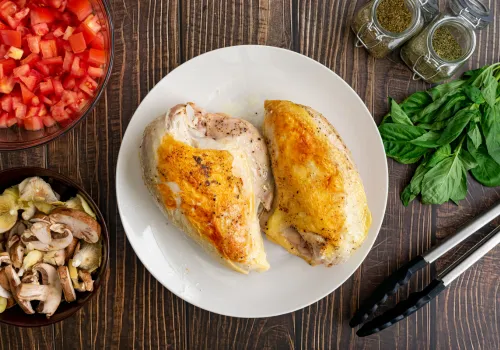
Lean and versatile, chicken breast is a favorite among fitness enthusiasts.
It’s low in fat and high in protein, making it an excellent choice for those watching their calorie intake.
2. Turkey breast
Similar to chicken, turkey breast is another lean poultry option that’s packed with protein and low in fat.
It’s a great alternative for those looking to vary their protein sources.
3. Lean beef (sirloin, flank steak)
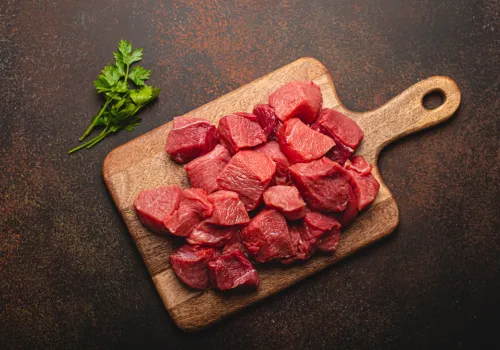
Beef is rich in protein and provides essential nutrients like iron and vitamin B12.
Choosing lean cuts helps reduce saturated fat intake while still providing high-quality protein.
4. Lamb
Lamb is a flavorful red meat that’s rich in protein and essential nutrients.
It’s particularly high in zinc, which is important for immune function and wound healing.
5. Bison
Bison meat is leaner than beef and has a slightly sweeter taste. It’s high in protein and rich in nutrients like iron and vitamin B12.
6. Venison
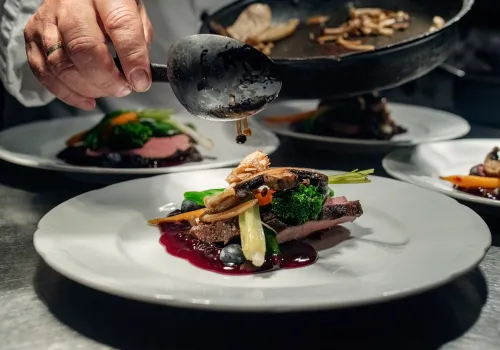
Venison, or deer meat, is very lean and high in protein.
It’s also a good source of iron and vitamin B12, making it a nutritious alternative to beef.
7. Duck breast
Duck breast is rich in protein and provides a unique flavor profile. While it’s higher in fat than chicken or turkey, much of this fat is healthier monounsaturated fat.
8. Rabbit
Rabbit meat is lean and high in protein. It’s also a good source of B vitamins and minerals like phosphorus and potassium.
9. Goat

Goat meat is lean and high in protein.
It’s popular in many cuisines around the world and provides a good amount of iron and potassium.
10. Quail
These small birds are packed with protein and provide a range of nutrients in a small package.
They’re often considered a delicacy in many cuisines.
Fish and Seafood

Fish and seafood are not only high in protein but also rich in omega-3 fatty acids, which are important for heart and brain health.
| Nutrient | Amount per 100g |
|---|---|
| Calories | 80-200 |
| Protein | 18-25g |
| Fat | 1-15g |
| Carbs | 0-5g |
11. Salmon
Salmon is rich in protein and omega-3 fatty acids.
It’s also a good source of vitamin D, which is important for bone health and immune function.
12. Tuna
Tuna is a lean fish that’s very high in protein. It’s also rich in B vitamins and selenium, an important antioxidant.
13. Tilapia
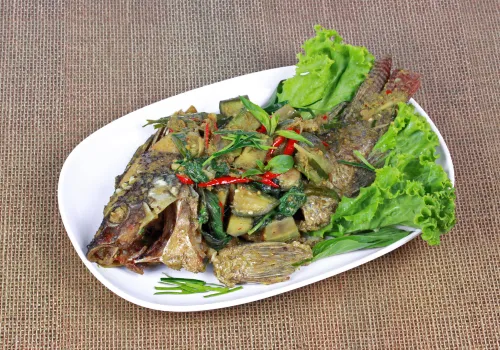
Tilapia is a mild-flavored fish that’s low in fat and high in protein. It’s a good option for those who don’t enjoy stronger-tasting fish.
14. Cod
Cod is a lean white fish that’s high in protein and low in fat. It’s also a good source of vitamin B12 and selenium.
15. Halibut
Halibut is a flatfish that’s high in protein and low in fat. It’s also a good source of selenium and magnesium.
16. Sardines
These small fish are packed with protein and omega-3 fatty acids. They’re also one of the few food sources of vitamin D.
17. Mackerel
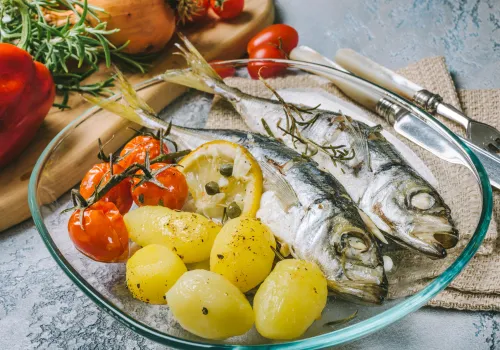
Mackerel is rich in protein and omega-3 fatty acids. It’s also a good source of vitamin B12 and selenium.
18. Trout
Trout is high in protein and omega-3 fatty acids. It’s also rich in potassium and vitamin D.
19. Shrimp
Shrimp are low in calories but high in protein. They’re also a good source of selenium and vitamin B12.
20. Crab
Crab meat is low in fat and high in protein. It’s also rich in vitamins and minerals like vitamin B12, zinc, and selenium.
21. Lobster
Lobster is high in protein and low in fat. It’s also a good source of copper and selenium.
22. Scallops
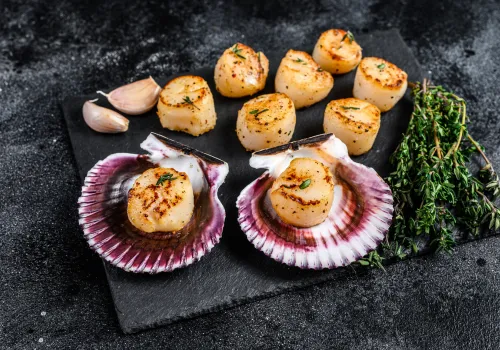
Scallops are low in calories but high in protein. They’re also a good source of magnesium and potassium.
23. Mussels
Mussels are high in protein and rich in vitamins and minerals, particularly vitamin B12 and iron.
24. Oysters
Oysters are low in calories but high in protein. They’re also an excellent source of zinc and vitamin B12.
25. Octopus
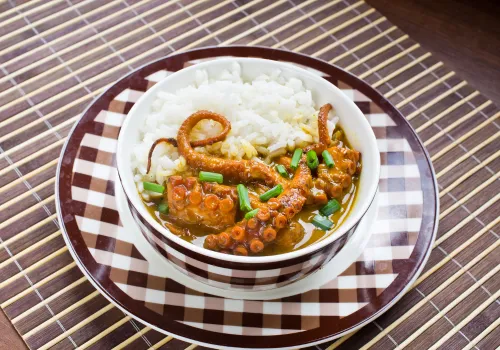
Octopus is high in protein and low in fat. It’s also a good source of iron and vitamin B12.
26. Anchovies
These small fish are packed with protein and omega-3 fatty acids.
They’re also rich in calcium and iron.
27. Haddock
Haddock is a lean white fish that’s high in protein and low in fat. It’s also a good source of vitamin B12 and selenium.
28. Catfish
Catfish is a mild-flavored fish that’s high in protein. It’s also a good source of vitamin B12 and phosphorus.
29. Swordfish
Swordfish is high in protein and provides a good amount of selenium and vitamin D.
30. Barramundi
Barramundi is a white fish that’s high in protein and omega-3 fatty acids. It’s also a sustainable seafood choice.
Eggs and Dairy
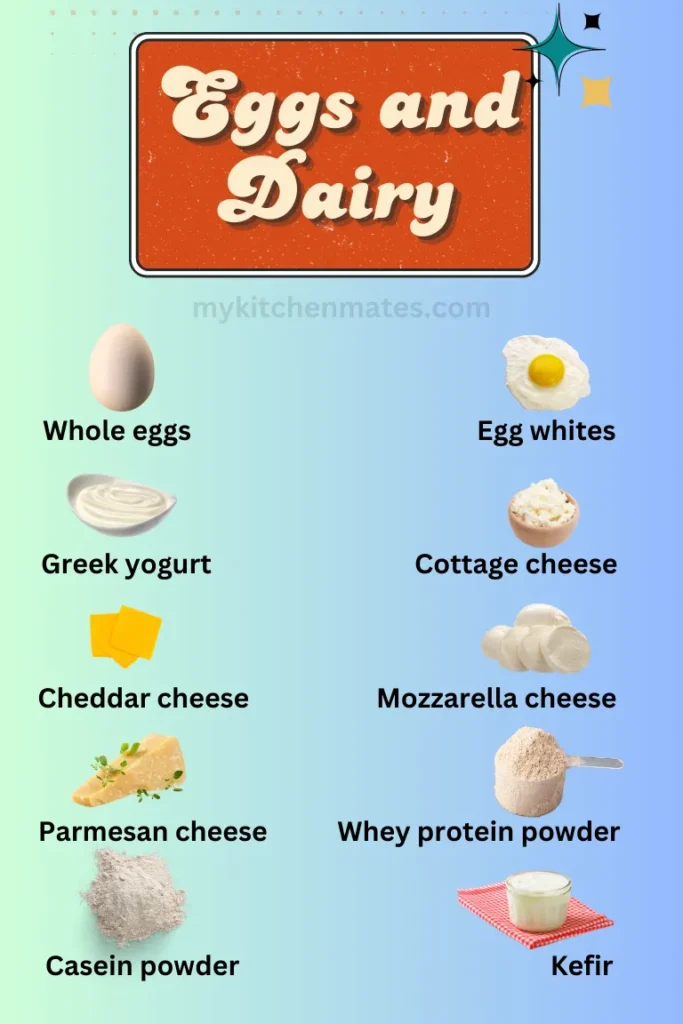
Eggs and dairy products are excellent sources of protein and provide additional nutrients like calcium and vitamin D.
| Nutrient | Amount per 100g |
|---|---|
| Calories | 50-400 |
| Protein | 3-36g |
| Fat | 0-33g |
| Carbs | 0-5g |
31. Whole eggs
Eggs are a complete protein source, meaning they contain all nine essential amino acids. They’re also rich in vitamins and minerals.
32. Egg whites
Egg whites are almost pure protein with very little fat.
They’re a popular choice for those looking to increase protein intake while keeping calories low.
33. Greek yogurt
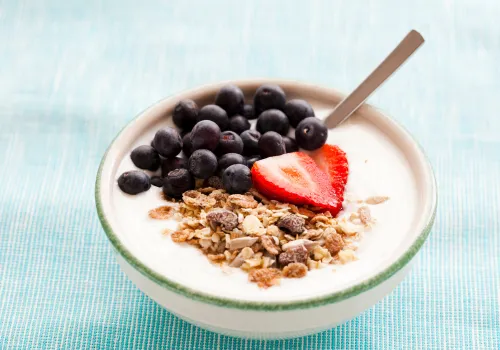
Greek yogurt is higher in protein than regular yogurt. It’s also a good source of probiotics, which are beneficial for gut health.
34. Cottage cheese
Cottage cheese is low in fat and high in protein. It’s also a good source of calcium and phosphorus.
35. Cheddar cheese
Cheddar cheese is high in protein and calcium. It’s also a good source of vitamin A and zinc.
36. Mozzarella cheese
Mozzarella is lower in calories than many other cheeses but still provides a good amount of protein and calcium.
37. Parmesan cheese
Parmesan is very high in protein and calcium. It’s also a good source of phosphorus.
38. Whey protein powder
Whey protein is a fast-absorbing protein that’s popular among athletes. It’s derived from milk during the cheese-making process.
39. Casein protein powder
Casein is a slow-absorbing protein also derived from milk. It’s often used as a nighttime protein source.
40. Kefir
Kefir is a fermented milk drink that’s high in protein and probiotics. It’s similar to yogurt but in a more drinkable form.
Plant-Based Proteins
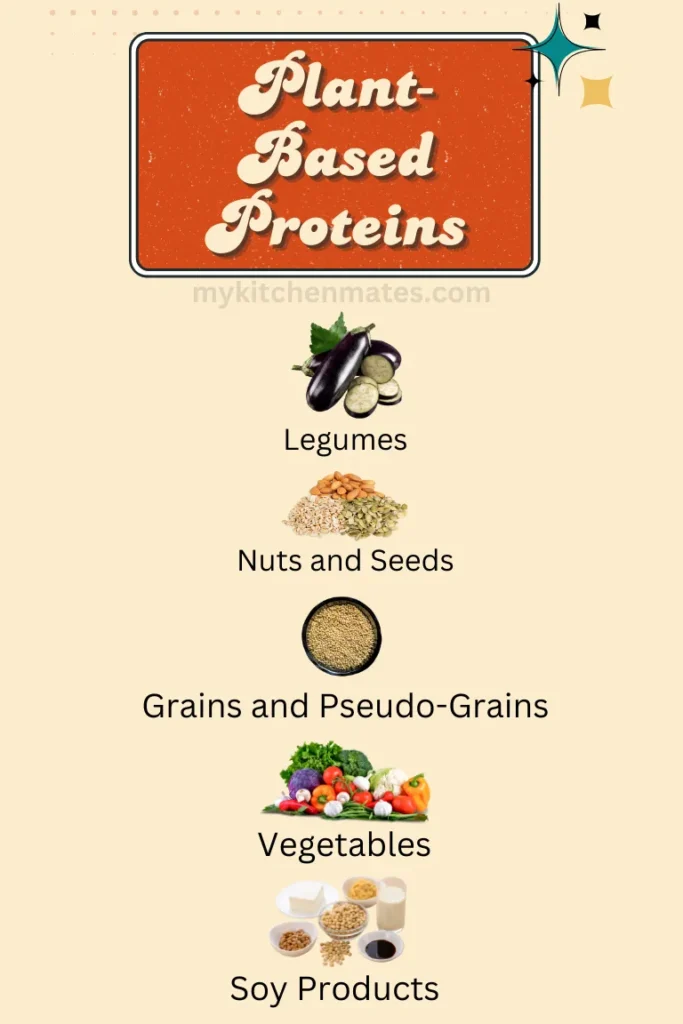
Plant-based proteins can be excellent alternatives to animal proteins.
While most plant proteins are not complete proteins on their own, eating a variety of plant-based proteins throughout the day can provide all essential amino acids.
Legumes
Legumes are not only high in protein but also rich in fiber, which is important for digestive health and feeling full.
| Nutrient | Amount per 100g (cooked) |
|---|---|
| Calories | 100-150 |
| Protein | 8-15g |
| Fat | 0-1g |
| Carbs | 20-30g |
41. Lentils
Lentils are high in protein and fiber. They’re also a good source of iron and folate.
42. Black beans
Black beans are rich in protein and fiber. They’re also high in antioxidants and provide a good amount of iron.
43. Kidney beans
Kidney beans are high in protein and fiber. They’re also rich in minerals like iron and phosphorus.
44. Chickpeas
Also known as garbanzo beans, chickpeas are high in protein and fiber. They’re versatile and can be used in many dishes.
45. Pinto beans
Pinto beans are rich in protein and fiber. They’re also a good source of folate and manganese.
46. Navy beans
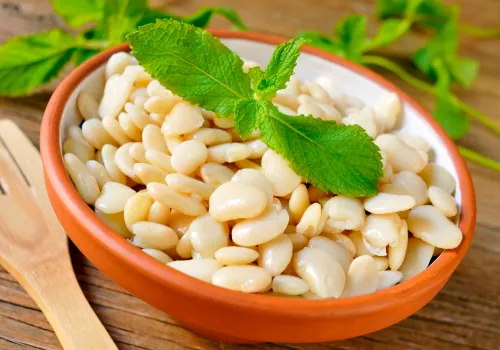
Navy beans are small white beans that are high in protein and fiber. They’re also rich in folate and manganese.
47. Soybeans
Soybeans are one of the few plant sources of complete protein. They’re also high in fiber and minerals.
48. Peanuts
Although technically a legume, peanuts are often grouped with nuts. They’re high in protein and healthy fats.
49. Split peas
Split peas are high in protein and fiber. They’re also a good source of various B vitamins.
50. Lima beans
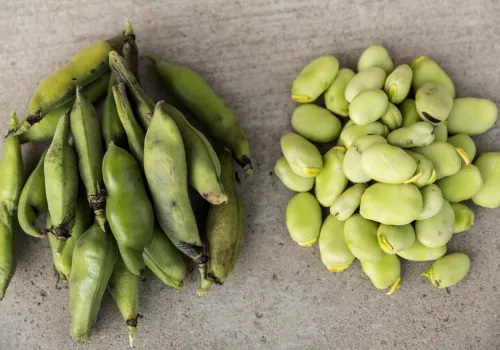
Lima beans are high in protein and fiber. They’re also rich in minerals like manganese and copper.
51. Mung beans
Mung beans are small green beans that are high in protein and fiber. They’re also rich in antioxidants.
52. Adzuki beans
Adzuki beans are small red beans that are high in protein and fiber. They’re popular in Asian cuisines.
53. Fava beans
Also known as broad beans, fava beans are high in protein and fiber. They’re also rich in folate and manganese.
54. Black-eyed peas
Black-eyed peas are high in protein and fiber. They’re also a good source of vitamin A and folate.
Nuts and Seeds
Nuts and seeds are not only high in protein but also rich in healthy fats and various vitamins and minerals.
| Nutrient | Amount per 100g |
|---|---|
| Calories | 500-700 |
| Protein | 15-25g |
| Fat | 40-65g |
| Carbs | 10-20g |
55. Almonds
Almonds are high in protein and healthy fats. They’re also a good source of vitamin E and magnesium.
56. Walnuts

Walnuts are rich in protein and omega-3 fatty acids. They’re also high in antioxidants.
57. Pistachios
Pistachios are high in protein and provide a good amount of fiber. They’re also rich in antioxidants.
58. Cashews
Cashews are rich in protein and healthy fats. They’re also a good source of copper and magnesium.
59. Pumpkin seeds
Pumpkin seeds are high in protein and provide a good amount of zinc and magnesium.
60. Sunflower seeds
Sunflower seeds are rich in protein and vitamin E. They’re also a good source of selenium.
61. Chia seeds
Chia seeds are high in protein and omega-3 fatty acids. They’re also rich in fiber and calcium.
62. Flaxseeds
Flaxseeds are high in protein and omega-3 fatty acids. They’re also rich in lignans, which are plant compounds with antioxidant properties.
63. Hemp seeds
Hemp seeds are a complete protein source. They’re also rich in healthy fats and minerals like zinc and iron.
64. Brazil nuts

Brazil nuts are high in protein and selenium. Just one or two Brazil nuts can provide your daily selenium needs.
65. Macadamia nuts
Macadamia nuts are high in protein and monounsaturated fats. They’re also a good source of manganese.
66. Pecans
Pecans are rich in protein and healthy fats. They’re also high in antioxidants and minerals like manganese.
67. Pine nuts
Pine nuts are high in protein and provide a good amount of iron and magnesium.
68. Sesame seeds
Sesame seeds are high in protein and provide a good amount of calcium and iron.
Grains and Pseudo-Grains
While not as high in protein as legumes or nuts, many grains and pseudo-grains provide a good amount of protein along with complex carbohydrates and fiber.
| Nutrient | Amount per 100g (cooked) |
|---|---|
| Calories | 100-150 |
| Protein | 3-8g |
| Fat | 1-3g |
| Carbs | 20-30g |
69. Quinoa
Quinoa is a complete protein, containing all nine essential amino acids. It’s also high in fiber and various minerals.
70. Amaranth
Amaranth is high in protein and provides a good amount of calcium and iron.
71. Teff
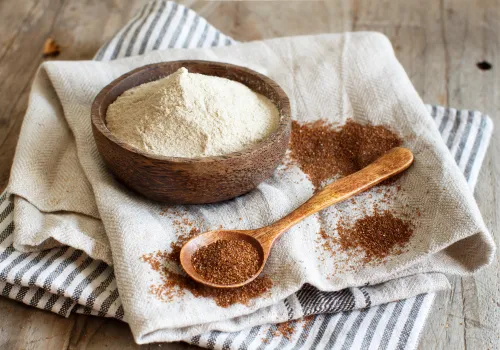
Teff is a small grain that’s high in protein. It’s also rich in fiber and minerals like iron and calcium.
72. Buckwheat
Despite its name, buckwheat is not related to wheat. It’s high in protein and provides a good amount of manganese and magnesium.
73. Oats
Oats are high in protein compared to most other grains. They’re also rich in a type of soluble fiber called beta-glucan.
74. Spelt
Spelt is an ancient grain that’s higher in protein than modern wheat. It’s also a good source of fiber and various B vitamins.
75. Kamut
Kamut is an ancient grain that’s higher in protein than modern wheat. It’s also rich in selenium and zinc.
76. Wild rice
Wild rice is higher in protein than most other grains. It’s also rich in antioxidants and provides a good amount of fiber.
77. Barley
Barley is high in fiber and provides a good amount of protein. It’s also rich in manganese and selenium.
78. Farro
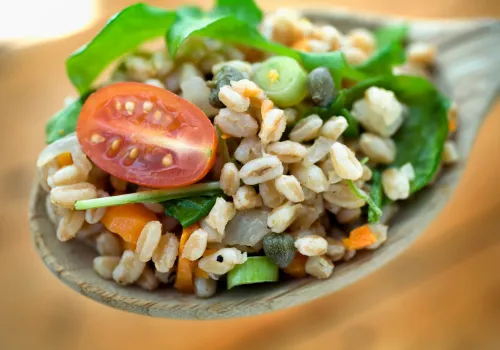
Farro is an ancient grain that’s high in protein. It’s also rich in fiber and provides a good amount of iron.
Vegetables
While vegetables are not typically thought of as protein sources, many provide a surprising amount of protein along with various vitamins, minerals, and antioxidants.
| Nutrient | Amount per 100g |
|---|---|
| Calories | 20-50 |
| Protein | 1-5g |
| Fat | 0-1g |
| Carbs | 3-10g |
79. Spinach
Spinach is surprisingly high in protein for a leafy green. It’s also rich in iron and various antioxidants.
80. Broccoli
Broccoli provides a good amount of protein along with fiber and various nutrients like vitamin C and K.
81. Brussels sprouts
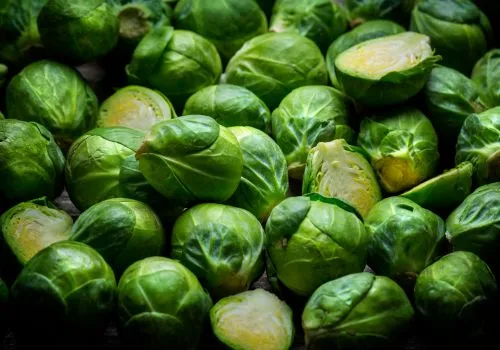
Brussels sprouts are high in protein for a vegetable. They’re also rich in vitamin C and K.
82. Asparagus
Asparagus provides a good amount of protein and is very low in calories. It’s also a good source of folate and vitamin K.
83. Artichokes
Artichokes provide a good amount of protein and are rich in fiber. They’re also high in antioxidants.
84. Peas
Peas are high in protein for a vegetable. They’re also rich in fiber and provide various vitamins and minerals.
85. Kale
Kale is high in protein for a leafy green. It’s also rich in vitamins A, C, and K, as well as antioxidants.
86. Mushrooms
While low in calories, mushrooms provide a good amount of protein. They’re also rich in B vitamins and selenium.
87. Cauliflower
Cauliflower provides a moderate amount of protein and is very low in calories. It’s also rich in vitamin C and various antioxidants.
88. Collard greens

Collard greens are high in protein for a leafy green. They’re also rich in vitamins A, C, and K.
89. Swiss chard
Swiss chard provides a good amount of protein for a leafy green. It’s also rich in vitamins A, C, and K.
90. Watercress
Watercress is high in protein for a leafy green and very low in calories. It’s also rich in vitamins A, C, and K.
91. Bok choy
Bok choy provides a good amount of protein and is low in calories. It’s also rich in vitamins A, C, and K.
92. Mustard greens
Mustard greens are high in protein for a leafy green. They’re also rich in vitamins A, C, and K.
93. Turnip greens
Turnip greens provide a good amount of protein for a leafy green. They’re also rich in vitamins A, C, and K.
94. Beet greens
Beet greens are high in protein for a leafy green. They’re also rich in vitamins A, C, and K.
95. Okra
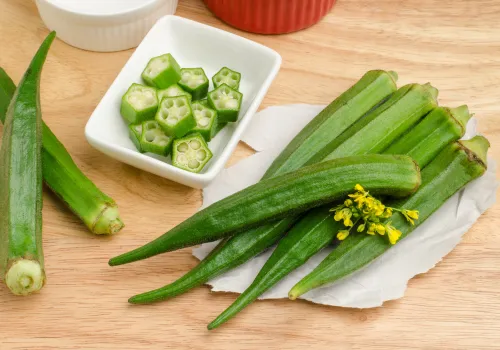
Okra provides a good amount of protein and is rich in fiber. It’s also a good source of vitamins C and K.
96. Green beans
Green beans provide a moderate amount of protein and are low in calories. They’re also a good source of vitamins C and K.
97. Snow peas
Snow peas provide a good amount of protein and are low in calories. They’re also rich in vitamins C and K.
98. Leeks
Leeks provide a moderate amount of protein and are low in calories. They’re also a good source of vitamins A and K.
Soy Products
Soy products are unique among plant proteins because they provide all essential amino acids, making them complete proteins.
| Nutrient | Amount per 100g |
|---|---|
| Calories | 70-200 |
| Protein | 8-20g |
| Fat | 4-12g |
| Carbs | 1-10g |
99. Tofu

Tofu is made from condensed soy milk and is high in protein. It’s also a good source of iron and calcium.
100. Tempeh
Tempeh is made from fermented soybeans and is even higher in protein than tofu. It’s also rich in probiotics due to the fermentation process.
101. Edamame
Edamame are immature soybeans that are high in protein. They’re also rich in fiber and various vitamins and minerals.
Final Thoughts
Protein is an essential nutrient that plays many crucial roles in our bodies.
By incorporating a variety of these high-protein foods into your diet, you can ensure that you’re getting all the essential amino acids your body needs.
Remember, a balanced diet includes not just protein, but also carbohydrates, healthy fats, vitamins, and minerals.
Always consult with a healthcare professional or registered dietitian before making significant changes to your diet.